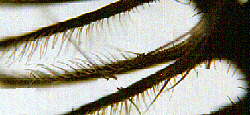 |
Written by Anne Bruce |
 |
 |
Written by Anne Bruce |
 |
The scent language
The importance of smell in insect communication was first recognised by the French entomologist, Jean Henri Fabre (1823-1915). His studies involved keeping female eggar moths (Lasiocampa quercus) in wire cages. He then surrounded the cages with a whole cocktail of smells (naphthalene, lavender water, hydrogen sulphide and petrol); also as lab safety rules were none too stringent the moths had, in addition, to suffer the scientist's strong tobacco smoke. Despite this off-putting olfactory assault male moths flew in, attracted to a chemical the female produced, quite undeterred by the surrounding smells.
The Greeks made a word for it
It wasn't until the 1950's that the term "pheromone", was coined to describe those chemicals which are a great sexual turn on for many insects. Translated, pheromone becomes the more expressive "excitement carrier" (from the Greek words "phero" and "hormone"). Pheromones are chemical messengers like hormones but instead of carrying information within an individual they carry information between individuals of the same species.
Feeling for the smell
 The male
emperor moth can pick up a female's scent at an amazing distance
of 5 kilometres. Just one molecule of the right type is enough to
send him flying upwind in search of his soul mate. How does he
achieve this remarkable feat? A look at his antennae (feelers)
provides an answer. Each antenna is a feathery plume covered in
lots of sensory hairs, (see image right), all tuned in to the
female's scent chemical which she emits from a special gland in
her abdomen.
The male
emperor moth can pick up a female's scent at an amazing distance
of 5 kilometres. Just one molecule of the right type is enough to
send him flying upwind in search of his soul mate. How does he
achieve this remarkable feat? A look at his antennae (feelers)
provides an answer. Each antenna is a feathery plume covered in
lots of sensory hairs, (see image right), all tuned in to the
female's scent chemical which she emits from a special gland in
her abdomen.
It's not just the female insects that "wear" the alluring perfume, in some species, such as the Salt marsh moth, it is both sexes that send out scented signals. This results in group meetings and the female can then make her choice. Cotton leaf worm moths also both produce pheromones, however, the first male to arrive at the female then releases another chemical which acts as a jamming device to confuse and deter other hopefuls.
What do the females in over 100 insect species and the female Asian elephant have in common?
Amazingly, they all produce an identical chemical. ((Z)-7-dodecen-1-yl acetate). Production by insect females signals a readiness to mate while the female elephant secretes the same chemical in her urine just before ovulation. This discovery obviously merited further investigation and studies have shown that this chemical elicits a response called the "flehmen" response in bull elephants. When exposed to (Z)-7-dodecen-1-yl acetate the bull elephant will touch the chemical with its trunk (having no antennae!) and then reach its trunk into its mouth and apply the chemical to the roof its mouth where the vomeronasal organ is situated.
So what is the vomeronasal organ?
Studies have shown that most vertebrate species have a vomeronasal organ (VNO) situated in their nasal cavity. The purpose of the VNO seems to be dedicated to detecting those chemical signals involved in sexual and territorial behaviour. The female Prairie vole (Microtus ochrogaster) for example will take a few drops of the males urine during courtship; any male pheromone in it will stimulate the female's VNO which triggers the brain to release hormones to start oestrus. Such pheromones can make the prairie vole's uterus triple in size, and stimulate her to ovulate within two days.
If most vertebrate species have a VNO, what about man?
Although a Dutch surgeon (Ruysch) identified a small organ in the nose as the vomeronasal organ in 1703 there have been conflicting views as to its importance and existence. One school of thought supports Ruysch, another believes that the organ is none existent or vestigial. Recent studies do, however, now seem to be coming down in favour of the first school of thought. The human VNO consists of two small sacs about 2 mm deep about 1 cm up from the nostrils, opening into shallow pits with tiny openings in their centres that are about 0.1 mm across. Just for comparison - the elephant's VNO is 20 - 25 cm long!
If we have a VNO - what next?
When anatomist Dr David Berliner was investigating the composition of human skin he found that when he left vials containing skin extracts open, the feelings of himself and people round about seemed to change - becoming warmer and friendlier. Such feelings were reduced if the vials were covered. These findings led him to investigate the potential that different compounds have in stimulating the "sixth sense" organ, the VNO and to look into the use of pheromones as perfumes, so giving nature a helping hand on the romance front. In the future, we may well be wearing minute but nevertheless potent quantities of human pheromone in order to attract our Valentines.
Some useful references:
Comments on the article to the author Anne Bruce
Please report any Web problems
or offer general comments to the Micscape Editor,
via the contact on current Micscape Index.
Micscape is the on-line monthly
magazine of the Microscopy UK web
site at Microscopy-UK